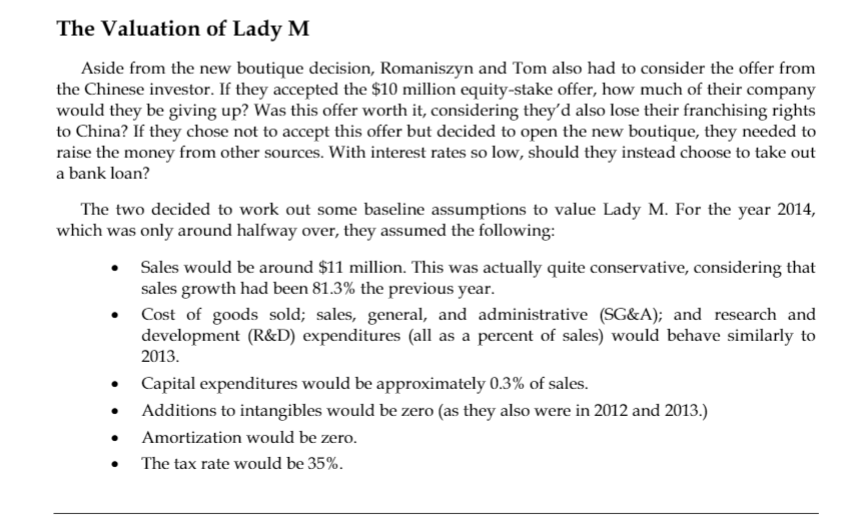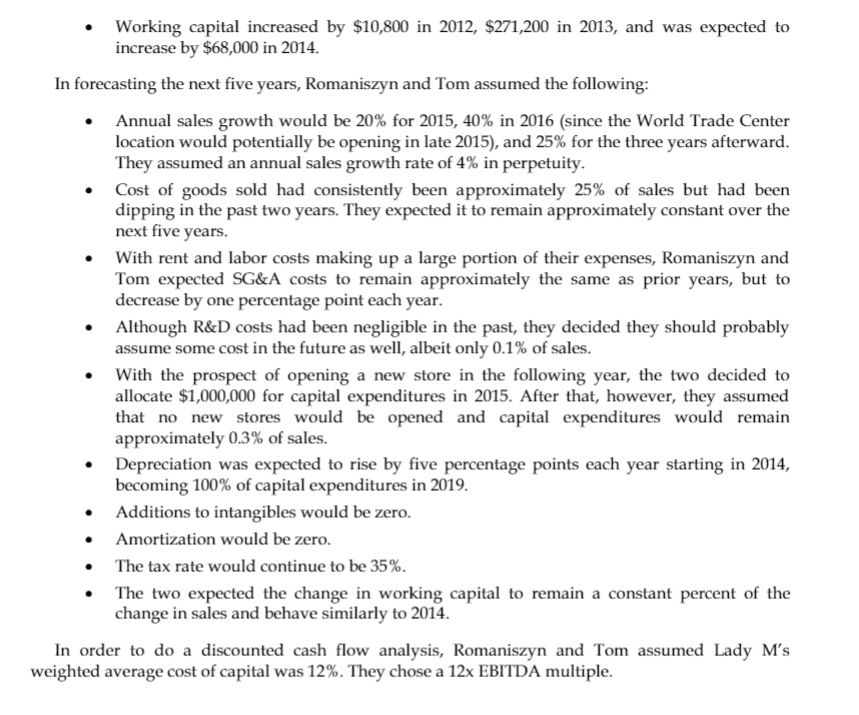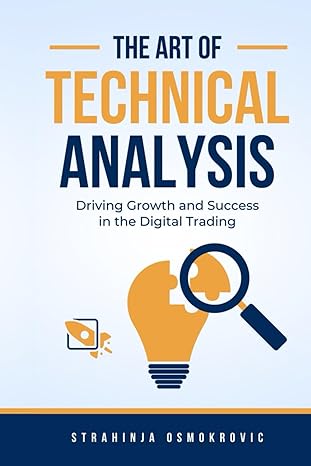What is the current valuation of Lady M? (Comes from the valuation and financing of Lady M Confections case study)


The Valuation of Lady M Aside from the new boutique decision, Romaniszyn and Tom also had to consider the offer from the Chinese investor. If they accepted the $10 million equity-stake offer, how much of their company would they be giving up? Was this offer worth it, considering they'd also lose their franchising rights to China? If they chose not to accept this offer but decided to open the new boutique, they needed to raise the money from other sources. With interest rates so low, should they instead choose to take out a bank loan? The two decided to work out some baseline assumptions to value Lady M. For the year 2014, which was only around halfway over, they assumed the following: Sales would be around $11 million. This was actually quite conservative, considering that sales growth had been 81.3% the previous year. Cost of goods sold; sales, general, and administrative (SG&A); and research and development (R&D) expenditures (all as a percent of sales) would behave similarly to 2013. Capital expenditures would be approximately 0.3% of sales. Additions to intangibles would be zero (as they also were in 2012 and 2013.) Amortization would be zero. The tax rate would be 35%. Working capital increased by $10,800 in 2012, $271,200 in 2013, and was expected to increase by $68,000 in 2014. In forecasting the next five years, Romaniszyn and Tom assumed the following: Annual sales growth would be 20% for 2015, 40% in 2016 (since the World Trade Center location would potentially be opening in late 2015), and 25% for the three years afterward. They assumed an annual sales growth rate of 4% in perpetuity. Cost of goods sold had consistently been approximately 25% of sales but had been dipping in the past two years. They expected it to remain approximately constant over the next five years. With rent and labor costs making up a large portion of their expenses, Romaniszyn and Tom expected SG&A costs to remain approximately the same as prior years, but to decrease by one percentage point each year. Although R&D costs had been negligible in the past, they decided they should probably assume some cost in the future as well, albeit only 0.1% of sales. With the prospect of opening a new store in the following year, the two decided to allocate $1,000,000 for capital expenditures in 2015. After that, however, they assumed that no new stores would be opened and capital expenditures would remain approximately 0.3% of sales. Depreciation was expected to rise by five percentage points each year starting in 2014, becoming 100% of capital expenditures in 2019. Additions to intangibles would be zero. Amortization would be zero. The tax rate would continue to be 35%. The two expected the change in working capital to remain a constant percent of the change in sales and behave similarly to 2014. In order to do a discounted cash flow analysis, Romaniszyn and Tom assumed Lady M's weighted average cost of capital was 12%. They chose a 12x EBITDA multiple. The Valuation of Lady M Aside from the new boutique decision, Romaniszyn and Tom also had to consider the offer from the Chinese investor. If they accepted the $10 million equity-stake offer, how much of their company would they be giving up? Was this offer worth it, considering they'd also lose their franchising rights to China? If they chose not to accept this offer but decided to open the new boutique, they needed to raise the money from other sources. With interest rates so low, should they instead choose to take out a bank loan? The two decided to work out some baseline assumptions to value Lady M. For the year 2014, which was only around halfway over, they assumed the following: Sales would be around $11 million. This was actually quite conservative, considering that sales growth had been 81.3% the previous year. Cost of goods sold; sales, general, and administrative (SG&A); and research and development (R&D) expenditures (all as a percent of sales) would behave similarly to 2013. Capital expenditures would be approximately 0.3% of sales. Additions to intangibles would be zero (as they also were in 2012 and 2013.) Amortization would be zero. The tax rate would be 35%. Working capital increased by $10,800 in 2012, $271,200 in 2013, and was expected to increase by $68,000 in 2014. In forecasting the next five years, Romaniszyn and Tom assumed the following: Annual sales growth would be 20% for 2015, 40% in 2016 (since the World Trade Center location would potentially be opening in late 2015), and 25% for the three years afterward. They assumed an annual sales growth rate of 4% in perpetuity. Cost of goods sold had consistently been approximately 25% of sales but had been dipping in the past two years. They expected it to remain approximately constant over the next five years. With rent and labor costs making up a large portion of their expenses, Romaniszyn and Tom expected SG&A costs to remain approximately the same as prior years, but to decrease by one percentage point each year. Although R&D costs had been negligible in the past, they decided they should probably assume some cost in the future as well, albeit only 0.1% of sales. With the prospect of opening a new store in the following year, the two decided to allocate $1,000,000 for capital expenditures in 2015. After that, however, they assumed that no new stores would be opened and capital expenditures would remain approximately 0.3% of sales. Depreciation was expected to rise by five percentage points each year starting in 2014, becoming 100% of capital expenditures in 2019. Additions to intangibles would be zero. Amortization would be zero. The tax rate would continue to be 35%. The two expected the change in working capital to remain a constant percent of the change in sales and behave similarly to 2014. In order to do a discounted cash flow analysis, Romaniszyn and Tom assumed Lady M's weighted average cost of capital was 12%. They chose a 12x EBITDA multiple








